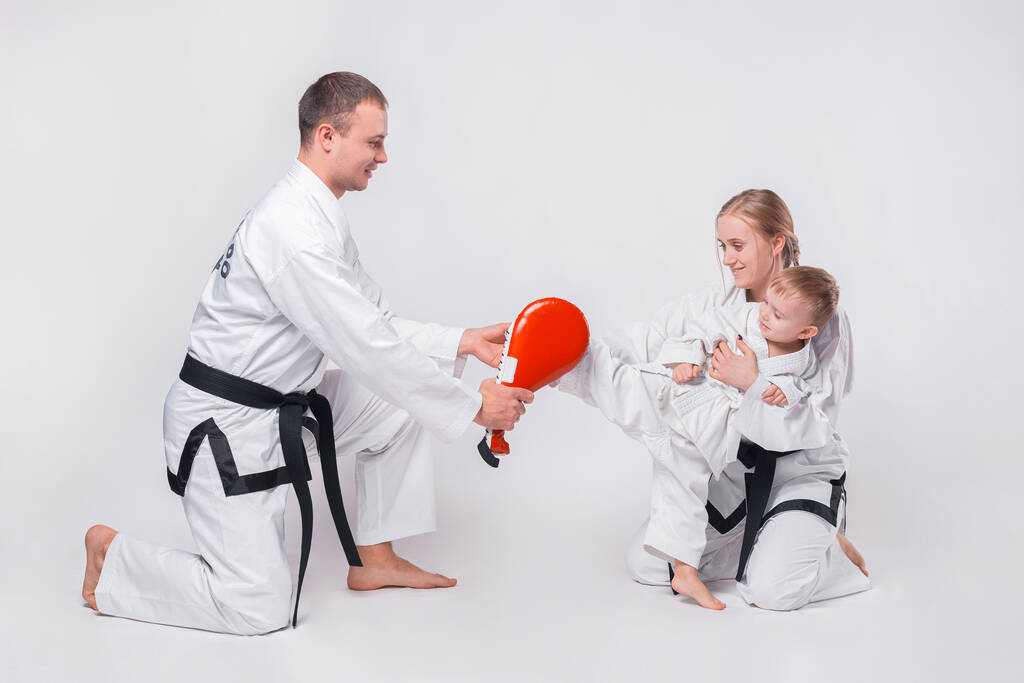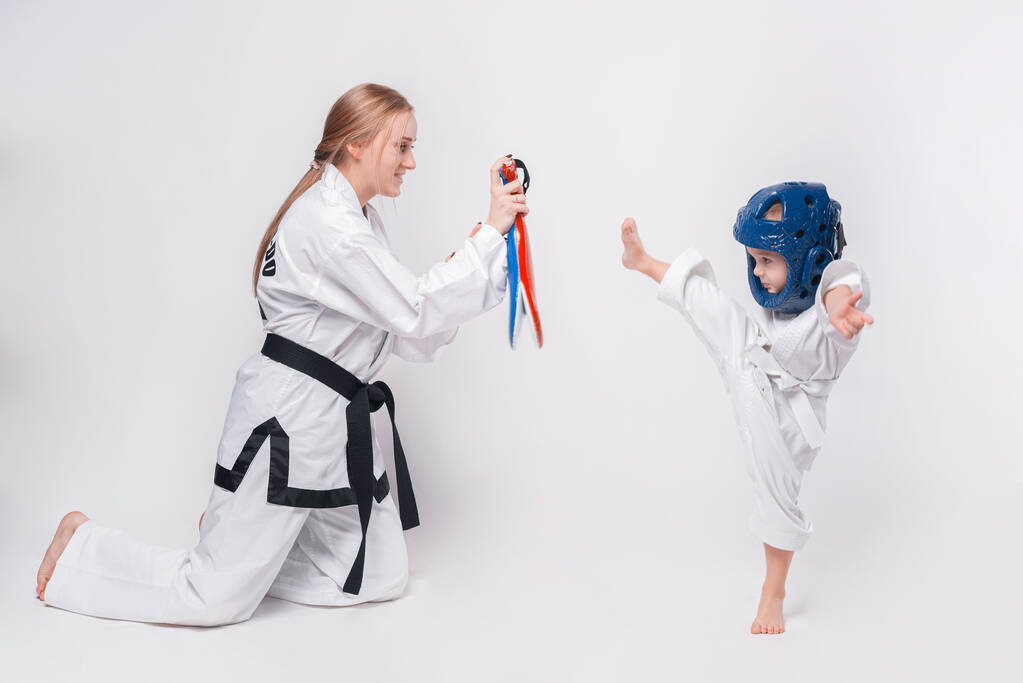Discover the essential tips and techniques for teaching self-defense to 2-3 year old children in this comprehensive guide.
Teaching Self-Defense to 2-3 Year Old Children: A Guide
Teaching self-defense to 2-3 year old children may seem like a daunting task, but with the right approach, it can be a fun and empowering experience for both you and your child. In this guide, we will explore the importance of self-defense for toddlers, basic techniques suitable for their age and development, incorporating self-defense into playtime, communicating about self-defense with your child, and how to monitor their progress while ensuring their safety.

Understanding the Importance of Self-Defense for Toddlers
Toddlers are curious beings who are just beginning to explore the world around them. As they grow and become more independent, it is vital to equip them with the skills to protect themselves. Self-defense not only teaches toddlers how to physically protect themselves but also lays a foundation for important life skills such as self-confidence, self-discipline, and problem-solving.
The Role of Self-Defense in Child Development
Self-defense plays a significant role in the overall development of a toddler. It enhances their motor skills, coordination, and spatial awareness. When toddlers engage in self-defense activities, they learn how to move their bodies in different ways, improving their balance and agility. These physical skills are not only important for self-defense but also for various other activities in their daily lives, such as playing sports or participating in physical education classes.
Moreover, self-defense helps toddlers develop discipline and respect for boundaries. Through structured training, they learn to follow instructions and practice self-control. This discipline extends beyond the training sessions and becomes a part of their everyday behavior. They understand the importance of respecting personal space and boundaries, which contributes to their overall social development.
Engaging in self-defense activities also boosts a toddler’s self-esteem and instills a sense of empowerment. As they learn new techniques and see their progress, they gain confidence in their abilities. This newfound self-confidence extends beyond self-defense and positively impacts their interactions with peers and adults. They become more assertive and less likely to be victims of bullying or other forms of aggression.
Addressing Safety Concerns for Toddlers
Safety should always be a top priority when teaching self-defense to toddlers. Activities should be age-appropriate, taking into consideration their physical capabilities and limitations. It is essential to choose techniques and exercises that are safe and suitable for their age group.
Parents should closely supervise the self-defense sessions to ensure that their toddlers are practicing the techniques correctly and safely. This supervision not only helps prevent accidents but also allows parents to provide guidance and encouragement to their children. By actively participating in their child’s self-defense journey, parents can strengthen the bond with their toddlers and create a supportive learning environment.
Creating a safe learning environment is crucial for toddlers’ well-being. This includes ensuring proper equipment, such as protective padding and gear, to minimize the risk of injuries during training. The training area should have adequate space for toddlers to move around freely without any obstructions. Removing any potential hazards from the training area, such as sharp objects or slippery surfaces, is also essential to maintain a safe environment.
Encouraging open communication with your child is vital when teaching self-defense. Toddlers may have concerns or fears about the training, and it is important to address them. By actively listening to their worries and providing reassurance, parents can help alleviate any anxieties and create a positive learning experience for their toddlers.
In conclusion, self-defense is not just about physical protection for toddlers. It plays a crucial role in their overall development, enhancing their motor skills, discipline, and self-esteem. By addressing safety concerns and creating a safe learning environment, parents can empower their toddlers with the necessary skills to navigate the world confidently.
Basic Self-Defense Techniques Suitable for Toddlers
Now that we understand the importance of self-defense for toddlers, let’s explore some basic techniques suitable for their age and development.
Introducing the Concept of Personal Space
Teach your child the importance of personal space and how to establish boundaries. It is crucial for toddlers to understand that their body is their own, and they have the right to say “no” when someone makes them uncomfortable. By introducing the concept of personal space at an early age, you are empowering your child to assert their boundaries and protect their well-being.
One effective way to teach personal space is through playful activities like Simon says or role-playing. By engaging in these games, you can reinforce the importance of respecting personal boundaries and help your child recognize when someone is invading their personal space. These activities also provide an opportunity for open communication, allowing your child to express their feelings and concerns.
Additionally, you can create a safe and nurturing environment where your child feels comfortable discussing personal space. Encourage them to share any experiences that made them feel uncomfortable or violated their personal boundaries. By listening attentively and validating their emotions, you are fostering a sense of trust and teaching them to advocate for themselves.
Teaching Simple Evasion Techniques
Aside from understanding personal space, it is essential for toddlers to learn simple evasion techniques. These techniques not only help them avoid potential dangers but also develop their reflexes and agility.
A fun and engaging way to teach evasion techniques is through imaginative play. You can pretend to be a playful monster while your child tries to dodge your tickles. This game not only brings laughter and joy but also teaches them how to move quickly and evade unexpected situations.
Another effective technique is incorporating obstacle courses into their playtime routine. Set up a mini obstacle course in your backyard or living room, including tunnels, cones, and hurdles. Encourage your child to navigate through the course, emphasizing the importance of agility and quick thinking. This activity not only enhances their physical abilities but also teaches them how to assess and respond to different obstacles.
Furthermore, you can introduce your child to basic martial arts movements suitable for their age. Simple techniques like ducking, sidestepping, and blocking can be taught in a playful and interactive manner. Enroll them in a toddler-friendly martial arts class where they can learn these techniques in a safe and supervised environment.
Remember, the goal is not to instill fear in your child but to empower them with the necessary skills and confidence to protect themselves. By teaching them basic self-defense techniques, you are equipping them with valuable life skills that will benefit them throughout their lives.
Incorporating Self-Defense into Playtime
One of the best ways to engage toddlers in learning self-defense is by incorporating it into their playtime. By turning self-defense into a game, you make it enjoyable and encourage them to practice their skills regularly.
Playtime is a crucial part of a child’s development, as it allows them to explore their imagination, develop social skills, and enhance their physical abilities. By integrating self-defense into their playtime, you not only provide them with valuable skills but also make it an exciting and interactive experience.
Children have a natural inclination towards play, and by making self-defense a part of their playtime routine, you create a positive association with the practice. This approach helps them view self-defense as something fun and empowering, rather than something intimidating or scary.
Fun and Safe Self-Defense Games
Create safe and age-appropriate games that allow your child to practice their self-defense techniques. For example, you can set up a playful obstacle course where they use evasion techniques to avoid obstacles and reach the finish line. Make it a silly and entertaining experience to keep them engaged.
Another fun game idea is to have your child pretend to be a superhero, using their self-defense moves to protect their imaginary city from villains. This game not only helps them practice their techniques but also boosts their confidence and creativity.
Additionally, you can introduce role-playing scenarios where your child gets to play the hero, rescuing their stuffed animals or action figures from imaginary danger. This game allows them to apply their self-defense skills in a practical and exciting way.
Using Toys to Teach Self-Defense
Utilize toys creatively to teach self-defense techniques. Use soft toys as “attackers” and demonstrate how to defend against them. By making it interactive and visually stimulating, your child will develop a strong foundation in self-defense while having loads of fun.
You can also incorporate storytelling into your playtime activities. Create narratives where the main character uses self-defense skills to overcome challenges and protect themselves and others. This storytelling approach not only makes the learning process more engaging but also helps your child understand the importance of self-defense in real-life situations.
Furthermore, consider using props such as foam noodles or inflatable punching bags to teach your child striking techniques. By providing them with a safe and controlled environment to practice these skills, you instill confidence and discipline in their self-defense practice.
Remember, the key to incorporating self-defense into playtime is to make it enjoyable, interactive, and age-appropriate. By doing so, you create a positive learning experience that empowers your child and equips them with valuable skills for their future.
Communicating About Self-Defense with Your Child
Open dialogue and age-appropriate explanations about self-defense are crucial to help your child understand its importance.
Explaining Self-Defense in Child-Friendly Terms
When discussing self-defense with your child, use simple and relatable language. Explain that self-defense means staying safe and protecting themselves from potential harm. Emphasize that it is not about fighting or being aggressive, but rather knowing how to respond to different situations.
Encouraging Open Dialogue About Safety
Encourage your child to ask questions and express any fears or concerns they may have. Listen attentively and address their worries, ensuring them that self-defense is a tool to empower them and keep them safe. By fostering a safe and open environment, you cultivate trust and understanding.
Monitoring Progress and Ensuring Safety
As your child progresses in their self-defense journey, it is essential to monitor their development and ensure their safety throughout the process.

Recognizing Signs of Progress in Your Child
Observe your child’s growth and celebrate their milestones. Notice their improved coordination, reflexes, and ability to establish boundaries. Praise their efforts and encourage them to continue practicing. Positive reinforcement will boost their confidence and motivate them to keep learning.
Ensuring Your Child’s Safety During Self-Defense Practice
Always prioritize your child’s safety during self-defense practice. Provide protective gear such as helmets, knee pads, and gloves to prevent injuries. Ensure they practice in a safe environment free from any hazards or distractions. Additionally, maintain constant supervision and encourage them to practice self-defense techniques only with trusted individuals.
Teaching self-defense to 2-3 year old children can be a thrilling adventure. By understanding the importance of self-defense, incorporating it into playtime, fostering open communication, and ensuring safety, you are equipping your child with valuable skills that will benefit them throughout their lives. Remember, the journey of self-defense is not just about physical techniques but also about empowering your child and nurturing their confidence. So, grab your child’s hand and embark on this joyous journey together!



